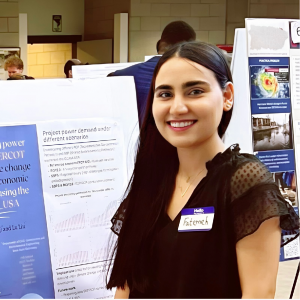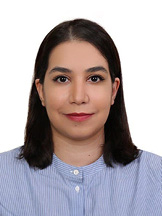Alex CleveringaAgronomy – Crop Production & Physiology Advisor: Dr. Fernando Miguez |
Title: Absolute Yield Instead of Relative Yield for Fertilizer Recommendations? Abstract: Relative yield has been used for decades to make fertilizer recommendations. However, there are a number of objections to using relative yield that have largely been ignored. The goal of this research is to analyze a dataset used to make potassium fertilizer recommendations for rice in Arkansas with mixed models and absolute yield and compare it to relative yield. The results indicate a comparable critical soil test value between the two methods and widely varying recommendations in the “Medium” soil test value category. These findings suggest that using absolute yield avoids the mathematical weaknesses of relative yield while minimizing harm to the environment and providing greater economic efficiency to producers. Additional research into identifying covariates will further improve the accuracy and specificity of these fertilizer recommendations. This methodology has the potential to apply to a variety of crops and nutrients around the world. |
Alexandra BarronChemical and Biological Engineering Advisor: Robert C. Brown |
Utilization of Waste Biogenic Carbon Dioxide for Production of Single Cell Protein Abstract: Greenhouse gas reductions in combination with carbon dioxide removal from the atmosphere will both be important in mitigating the worst impacts of global climate change. Among the possibilities is carbon capture and sequestration (CCS) of concentrated streams of carbon dioxide already being produced at biorefineries. For example, Summit Carbon Solutions has proposed to capture the CO2 emissions from several Iowa corn ethanol plants and transport it by a 1200-mile- long pipeline to North Dakota for sequestration in saline aquifers. However, CCS has been met with significant resistance from landowners through whose property the pipeline will pass. An alternative to CCS is carbon capture and utilization (CCU) with the CO2 employed in the manufacture of value-added products. Although CCU does not qualify as carbon removal if the product is quickly consumed and CO2 released to the atmosphere, it nevertheless avoids GHG emissions in the production of the targeted product by alternative, fossil fuel intensive processes.
We propose to utilize biogenic CO2 from corn ethanol plants to produce single cell protein (SCP). Carbon dioxide serves as the carbon source while hydrogen provides energy for the growth of hydrogen-oxidizing bacteria in a gas fermenter. The bacteria is suitable as protein supplement in ruminant animal feed. Hydrogen and oxygen for the process are produced through electrolysis of water powered by electricity from wind turbines. Preliminary results suggest that a 60 million gallon per year ethanol plant could produce enough single cell protein to feed over 60,000 head of cattle and supply animal protein to 100,000 people per year. Based on a selling price of $2000 per ton of dried single cell protein, the internal rate of return is estimated to be 15% with a payback period of 10 years. Accordingly, single cell protein could be economically competitive with fish meal as a protein supplement in animal diets. |
Angelos LagoudakisEconomics Advisor: Dr. Dermot J Hayes |
Food Access Inequality: Store Choices, Distance from Retailers, Food Away from Home, and Health Outcomes Abstract: For the last two decades, policymakers and researchers have sought to understand the drivers of poor health outcomes and nutritional inequality between wealthy and poor households in the United States. Previous literature has established that health outcomes of food purchases depend on the sociodemographic composition of the household and that the neighborhood environment does not contribute significantly to the existence of nutrition inequalities (Allcott et al., 2019; Taylor & Villas-Boas, 2016; Cummins et al., 2014). However, studies have yet to examine the effect of retailer type and distance from the household on health outcomes utilizing a dataset including retailers with access to midsize and small rural communities. My research’s initial analysis uses the National Household Food Acquisition and Purchase Survey (FoodAPS) dataset to estimate the health status of consumers as a function of outlet type, distance from the retailer, and household characteristics in linear regression analysis and a logistic regression model. My initial results indicate that the distance of the primary shopping location from the household and the type of store does not have a statistically significant effect on the health outcomes of the household. Nevertheless, in my future research steps, I will utilize proprietary household and retail scanner data from a global market research firm. Such a dataset might be more appropriate to answer my research questions. JEL classification: C25, D12, I12, I38 |
Connor ThorpeMaterials Science and Engineering Advisor: Dr. Shan Jiang |
Identifying Factors that Determine Effectiveness of Delivery Agents in Biolistic Delivery Using a Library of Amine-Containing Molecules Abstract: Biolistic transfection is a popular and versatile tool for plant transformation. A key step in the biolistic process is the binding of DNA to the heavy microprojectile using a delivery agent. Currently, the choice of the commercial delivery agent is mostly limited to spermidine and the detailed delivery mechanism has not been reported. To help reveal the fundamental mechanisms that lead to high delivery performance, a library of amine-containing molecules was investigated. A double-barrel biolistic device was utilized for testing hundreds of samples with much-improved consistency. The performance was evaluated on onion epidermis. The binding and release of DNA were measured via high-performance liquid chromatography. This study shows that the overwhelming majority of the amine library performed at the same level as spermidine. To further interpret these results, correlations were performed with thousands of molecular descriptors generated by chemical modeling. It was discovered that the overall charge is most likely the key factor to a successful binding and delivery. Furthermore, even after increasing the amount of the DNA concentration 50-fold to stress the binding capacity of the molecules, the amines in the library continued to deliver at a near identical level while binding all the DNA. This study greatly expands the delivery agent selection for biolistic delivery, allowing alternatives to a commercial reagent that are more shelf-stable and cheaper. |
Emmanuel Padmore ManteyCivil, Construction and Environmental Engineering Advisor: Dr. Lu Liu |
Cost curves: A novel decision-making tool in the water industry with focus on water reuse. Abstract: Many believe water should be free because it cycles through the earth’s surface. This water must be treated at a cost to make it potable. Government initiatives to increase the supply of essential human needs have led to subsidies that may not reflect the true cost of water and result in waste through the economics of traditional project finance. Traditional water resources management practices have ignored or underestimated economic valuation methods that assess the non-financial costs and benefits of various water supply options. This paradigm limits decision-makers and prevents economic growth if alternate water sources are explored. Traditional water management overlooks externalities, or side effects, that aren’t included in the market price of water to reflect its true cost. A recent approach to economic valuation monetizes intangible environmental and social externalities, sustaining water resources and endangered species through their benefits. Considering environmental and social advantages, cost curves can provide water resource planners with a cost-effective decision solution geared towards sustainability. This tool has minimal or no use in the water sector but is used in industries since water is inelastic and considered a public service. Cost curves can diversify a community’s water supply by including intangible benefits, thereby providing economic opportunities. This study will improve the community’s readiness for water reuse by offering a benefit-cost analysis tool for small systems that compare alternative water reuse sources to conventional sources bringing about some elasticity and competitiveness among the private sector. |
Elmin RahicAgricultural and Biosystems Engineering Advisor: Drs. Zhiyou Wen & Robert Brown |
Valorization of Biomass Through Pretreatment and Coproducts: A Biorefinery Approach Abstract: My research is focused on upgrading biomass and waste material for bioprocessing applications. Specifically, I have investigated two innovations: an HCA-extraction process that removes lignin from biomass and extracts high-value coproducts (hydroxycinnamic acids – HCA), and a novel method of producing high-yield laccase enzymes using pyrolysis light-ends. Bench-top experiments for the HCA-extraction of perennial feedstocks have shown HCA yields of 3.5% (w/w biomass) comprised of ferulic and p-coumaric acid. When evaluated in a continuous anaerobic digestion process, HCA-extracted biomass produced 133% more methane over untreated biomass. Bench-top experiments for laccase production showed a 7-fold increase in laccase yield using pyrolysis light-ends over common inducers, such as copper. Additionally, these laccases show significantly improved stability at higher pHs. Looking into various applications for these specific laccases, it was discovered that they are capable of significantly improving the digestibility of biomass, making them a potentially valuable enzyme for biomass pretreatment. Techno-economic analysis of these systems are currently underway. |
Fatemeh GanjiCivil, Construction and Environmental Engineering Advisor: Dr. Lu Liu |
Implications of climate change mitigation and socioeconomic development on the US electric power sector Abstract: Unprecedented climate change is impacting every sector of society and changing the way we live. Picking up the pace of emission reduction at the subnational level is central to achieving the national target in the US. End-use electrification contributes to the abatement of greenhouse gas emissions and is thus an effective way to mitigate climate change. Economy-wide electrification will spike demand for electricity, which largely depends on factors such as population, economics, policy, and regulations. Past research has projected US electricity demand under different assumptions, yet how each state responds to climate change mitigation under various socioeconomic development is unclear. Therefore, this research aims to advance understanding of the interplay between top-down climate change mitigation and socioeconomic development in affecting the US electric power sector at the state level. We used the Global Change Analysis Model, USA version (GCAM-USA). It is an integrated assessment model that assesses the dynamics of the coupled human-Earth system and its response to global changes. State-level future electric power demand was projected under four scenarios, namely: Low Emission-Low Population/GDP, Low Emission-High Population/GDP, Reference-Low Population/GDP, and Reference-High Population/GDP. We analyzed the relative impact of climate change mitigation and socioeconomic development on electricity demand for each state and identified spatial heterogeneity closely tied to the structure of the state’s economy. We predicted the levelized cost of electricity (LCOE) and analyzed the relative impact of mitigation and population dynamics on price fluctuations. This research is still ongoing, and preliminary results suggest that the electric power sector will respond differently to top-down climate change mitigation at the state level. Both mitigation and population dynamics will affect how each state would respond. This robust state-level assessment will provide useful insights for future electric power system planning that meets demand, mitigation, and economic objectives. |
Gabrielle Myers
Agricultural and Biosystems Engineering Advisor: Drs. Daniel S. Andersen, & D. Raj Raman, |
Can perennial groundcover (PGC) decrease nutrient export through subsurface drainage without negatively impacting corn yields? Results and challenges from two years of an Iowa field study. Abstract: Highly productive maize and soybean rotations are characteristic of the midwestern landscape. Traditionally, these crop rotations leave fields bare for extended periods. Because they lack living root systems, these bare fields are especially vulnerable to soil erosion and nutrient loss. Maize requires large nitrogen fertilizer inputs, with much of what is applied lost to groundwater, leading to far-reaching water quality consequences. Cover cropping systems have sought to alleviate these problems but have low adoption rates due to the timing of field activities and associated costs. The perennial groundcover (PGC) approach proposes the use of a continuous soil cover through perennial plant species growing in conjunction with the annual cash crop. This system may provide similar environmental benefits as traditional cover crops at a lower cost and with a reduced management burden. This study – which completed its first field season in the unusually dry summer of 2021 – aims to evaluate the PGC system’s effect on nitrogen export through field trials at the long-established water quality sites at the Northeast Research Facility in Nashua, IA. Kentucky bluegrass was established as a PGC in a continuous corn system. Data from two years of the study has been collected. Yield data from both years shows the PGC system did not significantly differ from the yield of a conventional continuous corn system. Statistical differences between nitrogen and phosphorus concentrations were also not observed. Poor grass establishment may have contributed to these results, and the PGC will be replanted in 2023. |
Ghazal Shah AbadiIndustrial and Manufacturing Systems Engineering Advisor: Dr. Sarah M. Ryan |
Reliability Assessment of Scenarios for CVaR Minimization for energy management system of microgrids in a chemical industry Abstract: Reliable scenarios play an important role in obtaining a high-quality solution to a stochastic program. Considering sets of scenarios sets and corresponding observed values of the uncertain parameters over a collection of historical instances, reliability is defined loosely as goodness of the scenarios’ fit to the observations. For two-stage, risk-neutral stochastic programs, a statistical tool motivated by ensemble forecast verification was developed previously to assess the reliability of any given scenario generation method. Over- or under-dispersion and/or bias in the scenario sets can be diagnosed by this tool. For risk-averse decision makers who aim to minimize CVaR of cost, only the scenarios that define the upper tail of the optimal cost distribution at the optimal solution are important. We develop a tool to assess the reliability of these so-called effective scenarios for CVaR minimization. We conduct simulation studies in the context of a financial investment problem to systematically explore the ability of the tool to detect mismatches in mean, variance, or kurtosis between scenarios and the corresponding observations. |
Holly Loper
Microbiology
|
How Well Can We Predict Nitrous Oxide Emissions? Abstract: My research uses an innovative field study design to precisely measure nitrogen losses from corn agriculture. Over the last three years using this design, I have taken numerous measurements including but not limited to nitrous oxide emitted, nitrate leached, and nitrogen removed in harvest to understand the nitrogen cycle in the context of the crop system. Equipped with this understanding, my goal is to help understand the environmental impacts of agriculture. Currently, I am using this data to evaluate current approaches to estimate nitrous oxide losses from continuous maize crop systems. So far, my results indicate that the effectiveness of our approaches to estimate nitrous oxide losses can vary from year to year. approaches using a general default emissions factor such that used in the IPCC tier one methodology may not be as accurate as approaches which can integrate biological demand through construction of a nitrogen balance. |
Jarrett MorrisonCivil, Construction, and Environmental Engineering Advisor: Dr. Lu Liu |
Abstract: |
Júlia Brittes TuthillAgricultural and Biosystems Engineering Advisor: Dr. Amy Kaleita |
Iowa Food-Energy-Water nexus (IFEWs) – a Data Synthesis, a Model Update, and a Visualization Tool Abstract: Hypoxic Zones are regions with a reduced level of oxygen in the water. They are a product of nutrient pollution. Excess Nitrogen that runs off from agricultural land can be one of the stimulators of an overgrowth of algae. Algae sink and decompose in the water, consuming oxygen and exhausting the supply available to healthy marine life. Because of Iowa’s agricultural importance and contribution between 11 and 52% to long-term nitrate load in the Mississippi-Atchafalaya Basin, it is necessary to describe and understand Iowa’s nutrient pollution and agricultural production. Nutrient pollution can be quantified by models already available. However, none of those englobe Iowa’s impact in food, energy, and water subsystems (IFEWs). I propose a synthesis between available FEW (Food, Energy, and Water nexus) models applied to the state of Iowa. The main objectives of my research are to 1) aggregate the energy, food, and feed sectors to Raul et al. (2020) IFEW model, 2) calculate the updated values of spatial and temporal nitrogen surplus and other IFEW variables, and 3) create the IFEW Dashboard as an interactive visualization tool that synthesizes IFEW’s publicly available data and facilitates visualization of data for decision-making.
|
Kelly Thompson Agricultural and Biosystems Engineering Advisor: Dr. Brian Gelder |
Daily Erosion Project Ground-Truth Analysis Through Its Application on Strips Sites Abstract: Soil erosion by water runoff and sediment transport are recognized to cause substantial impacts on water quality and crop production; thus, conservation planning and watershed management are crucial to mitigate soil loss and reestablish soil health. The Science-based Trials of Row-crops Integrated with Prairie Strips (STRIPS) have reported outstanding soil conservation effects attributed to the strategic placement of relatively small reconstructed prairie strips in row crop fields. Over several years of research, this practice has proven to be advantageous for nutrient retention, water quality, air quality, wildlife, and pollinator habitat. One current phase of this project focuses on evaluating prairie strips’ impact on commercial fields since initial experiments only took place at the Neal Smith National Wildlife Refuge. To aid in quantifying runoff, soil detachment, and sediment delivery, we are implementing STRIPS sites into the Daily Erosion Project (DEP), a successful modeling framework produced with the following components: Water Erosion Prediction Project (WEPP) model; soil, topography, and land management databases; meteorological data on precipitation, temperature, wind and solar radiation. The DEP generates daily estimates of soil erosion and water runoff at the HUC 12 watershed level. The partnership between DEP and STRIPS is evaluating the effect of established reconstructed prairie planted as contour filter strips on reducing hillslope runoff and sheet and rill soil erosion as well as validating the accuracy of the model in these complex environments. Furthermore, the DEP model will evaluate strategically placed prairie strip impacts on estimated hillslope soil erosion for different Major Land Resource Areas (MLRA). This project is testing this conservation’s practice suitability in commercial fields across multiple spatiotemporal variabilities occurring in different MLRAs through geospatial modeling. In summary, these results will help inform farmers’ and conservationists’ decisions when considering conservation practices most appropriate for their land. Kelly Nascimento Thompson, Brian Gelder, Richard Cruse, Daryl Herzmann, and David James. |
Kyle DeLong Agronomy- Ag Meteorology Advisor: Dr. Brian Hornbuckle |
TITLE: Validating Soil Moisture with Farmers in Mind: A New Validation Approach for Soil Moisture Remote Sensing in the Corn Belt. Abstract: Evaluating soil moisture information should consider when key crop development stages occur and ultimately when decisions based upon soil moisture status must be made by farmers. Therefore, we assessed the performance of three microwave satellites and three reanalysis models in the U.S. Corn Belt in the context of agricultural management. We considered the following soil moisture products: Soil Moisture Active Passive (SMAP), Soil Moisture and Ocean Salinity (SMOS), and Advanced Scatterometer (ASCAT)/METOP satellites; and Modern- Era Retrospective Analysis for Research and Applications v2 (MERRA-2), North American Regional Reanalysis (NARR), and Water Erosion Prediction Project (WEPP) reanalysis models. Estimated thermal time and crop progress and condition reports from the USDA NASS were used to define critical transition periods of crop growth and management decisions for the validation process. Contrary to calendar timelines like annual or monthly segments, these key events separate the growing season into five irregular segments: pre-planting, when soil moisture should be within an optimal range for planting and any management practices like tilling; active management, when field trafficability is needed for management practices during initial crop growth like pesticide applications; wet-minimal management, when little to no management practices occur during later crop development, but the water column density has not peaked; dry- minimal management, when little to no management occurs but after when the water column density has peaked; and post-harvest when activities for the next growing season occur. The validation process utilized 20 in-situ volumetric water content measurements between 2016 to 2020 at a depth of 5 cm in the South Fork of the Iowa River, Iowa, known as the South-Fork SMAP Core Validation Site. We found that, on average, the two passive satellite products were dry compared to in-situ observations for all validation segments. On the contrary, the active satellite and reanalysis model products were wetter than observations. |
Logan JohnsonAnimal Science Advisor: Dr. Steven Lonergan 3-minute video on research interest |
Utilizing Proteomic and Metabolomic Data to Predict Fresh Pork Loin Quality Abstract: Iowa is the leading pork producer in the United States, producing one-third or approximately 9 billion pounds of pork domestically. Understanding what controls pork quality and value are particularly important to the Iowa economy. A multitude of factors influences fresh pork meat quality. If pork producers and processors had a reliable means to merchandise and sort fresh pork into different categories and markets, they could more consistently meet consumer expectations for products in the marketplace and ultimately increase the value of pork. Rapid biochemical tests could measure specific metabolites or proteins to categorize and mechanize fresh pork. First, an understanding of the metabolites or proteins that are most closely related and associated with fresh pork quality is needed. Our work has applied mass spectrometry to measure and quantify metabolite and protein profiles of commercial pork loins. These data show that distinct proteomic and metabolomic profiles are linked with pork quality attributes and further improve our knowledge of the biochemical mechanisms associated with fresh pork quality. Additional research is needed to validate these proteins and metabolites as potential biomarkers for pork quality and determine the proteins and metabolites which can most accurately predict and sort fresh pork into distinct quality groups. |
Luke SokoAgricultural and Biosystems Engineering Advisor: Dr. Daniel S. Andersen |
FARM SIZE IMPACTS ECONOMIC FEASIBILITY OF IMPERMEABLE COVER TO BIOGAS SYSTEMS Abstract: Impermeable covers have been one of the most popular choices for implementing manure anaerobic digestion to biogas projects; however, no study has evaluated how economies of scale affect the profitability of impermeable cover projects. Here, we assess dairy farms ranging from 100 to 10,000 head and swine farms ranging from 1200 to 100,000 head to determine which projects would be economically viable. System construction costs are estimated using literature values, with potential revenue streams estimated using average market prices. Results showed the economies of scale of impermeable cover projects are relatively linear. Estimated break-even farms sizes were 557 dairy cows, 5497 swine finishing pigs if the initial systems were lagoon manure storage, and 16,282 swine finishing pigs if initially a deep pit manure storage was used. While there are more than 7600 swine farms and 170 dairy farms in Iowa, only 100 individual farms in Iowa would profit using impermeable covers due to typical farm sizes and manure management systems prevalent in the Midwestern United States. Future work must explore and develop strategies for use on smaller farms with other manure management systems. One strategy may be hauling raw biogas from digesters to a community biogas upgrader and injection point. |
Matt KavanaughAgronomy- Ag Meteorology Advisor: Dr. Brian Hornbuckle |
Developing a Dynamic Planting and Harvesting Algorithm in order to Improve SMAP Soil Moisture Retrievals Abstract: NASA’s Soil Moisture Active Passive (SMAP) satellite has proven to be a useful tool for measuring soil moisture across the US Corn Belt and across many other parts of the world. However, certain limitations exist which prevent SMAP from producing reliable soil moisture retrievals at all times of the year. In fact, dry biases, in which SMAP soil moisture retrievals are consistently drier than in-situ soil moisture measurements, have been seen throughout most of the year, particularly in the spring and fall seasons. We hypothesize that this is due to SMAP algorithm’s inability to distinguish between dynamic soil surface roughness and crop cover during critical times of the year, which are planting and harvest times. In this study, we test a planting prediction algorithm using the Agro-IBIS model, which determines a crop planting date based on accumulated thermal time, soil moisture, and soil temperature. In-situ soil moisture observations taken from the South Fork Iowa River soil moisture observation network are used to validate this algorithm. Then, we apply this model to other locations across the CONUS to determine which regions are most vulnerable to the observed seasonal pattern in SMAP soil moisture retrievals. It is hypothesized that interannual and spatial variability in snow melt, soil tillage practices, and drainage patterns remain as complicating factors in the SMAP retrieval algorithm during the late winter and early spring timeframe. These factors and their relationship to retrieval patterns will be analyzed in future work. |
Motahareh Kashanian Industrial and Manufacturing Systems Engineering Advisor: Dr. Sarah M. Ryan |
Chemical supply chain network design from biomass using green electrochemistry
Abstract:
The concern about environmental impact of industrial activities has spurred an interest in transition to renewable energy and designing environmentally conscious supply chains. In this regard, Electrochemistry has shown promising results in converting biomass into commodities. A mixed-integer linear programming model is used to optimize the location and capacity of distributed chemical facilities in a supply chain in order to examine the impact of electrochemistry technology on supply chain configuration. The economic objective of the supply chain model is to minimize the total annual costs for a 10-year chemicals production system. The proposed model analyzes the trade-off between environmental and economic considerations and includes an environmental objective of reducing CO2 emissions, along with the economic objective. Based on techno-economic analysis, the capital costs and operating costs of the facilities are calculated, and a case study of Iowa illustrates how the proposed approach is implemented. A real industrial case of the State Iowa used to demonstrate the significance and applicability of the developed model as well as the usefulness of the proposed solution approach. |
Nicole KlingFood Science and Human Nutrition: Interdepartmental Graduate Program in Nutritional Sciences Advisor: Dr. Lorraine Lanningham-Foster |
Assessment and Promotion of Environmentally Sustainable and Healthy Dietary Patterns
Abstract:
The average American diet is high in red and processed meats which increases one’s risk for chronic diseases and requires more land and water to produce and yield greater greenhouse gases (GHG) compared to other protein foods. Thus, the reduction of red and processed meat intake, such as seen with the Dietary Approaches to Stop Hypertension (DASH diet), could benefit human and environmental health. Recent research has shown that greater adherence to the DASH diet is associated with reduced GHG; however, little is known about the water withdrawals and land use associated with the dietary pattern. This study aims to fill this gap. Dietary data was collected from over 400 Midwesterners aged 35-70 years old with hypertension using the Automated Self-Administered 24-Hour (ASA-24) Recalls System. DASH diet adherence was measured using a nutrient-based DASH score. GHG, land use, and water withdrawals were obtained using Carnegie Mellon University’s Economic Input-Output Life Cycle Assessment (eiolca.net) using the Purchaser model (cradle-to-consumer). In general, diets that met DASH diet guidelines, as indicated by higher individual DASH nutrient scores, were associated with less GHG and land use from total and animal protein foods but more GHG and land use from plant-protein foods, with a few exceptions. The pattern was not clear for water withdrawals. Protein foods within more DASH adherent diets are less environmentally demanding, in terms of GHG and land use, than protein foods within less adherent diets. However, claims regarding the sustainability of the entire dietary pattern cannot be determined based off the current study. Regardless, it is evident that environmental impacts should be considered alongside health impacts when selecting and recommending a dietary pattern, especially as personal interest in climate change grows. Strategies, such as sustainability-focused cooking classes and food labels, should be explored through future research. |
Richard Magala Natural Resource Ecology and Management Advisor: Dr. Lisa Schulte Moore 3-minute video on research interest Poster link |
Abstract: |
Taylor VromanEnvironmental Science Advisor: Dr. Michelle Soupir |
Microbial Communities as a Pathway to Improved Woodchip Bioreactor Design and Performance Abstract: The Midwest serves as a global distributor for multitudes of products and services that are dependent upon agriculture. Iowa has a history of prairie potholes, depressional wetlands that flood agricultural lands. Drainage tiles were designed to lower the water table by removing water through underground pipes leading to nearby waterways. Nutrient export from crop fertilizer application via subsurface tile drainage continually results in water quality damage and potential harm to downstream communities on a local and global scale. Effects of excess nutrient loading can be observed at the “Dead Zone,” an area of hypoxia where the Mississippi River meets the Gulf of Mexico. Woodchip bioreactors are an upcoming edge-of-field technology that hold great promise as a designed method of denitrifying water. This technology involves an underground pit filled with woodchips directly intercepting tile drained fields. Woodchip bioreactors are novel technology in that these systems treat water with excess nutrient loads at a higher rate than traditional practices in a smaller physical area. Although we know that woodchip bioreactors are an effective conservation tool, we are not sure which microbes are responsible for denitrification. More research needs to be done to understand the microbial communities controlling the denitrification process. |




















